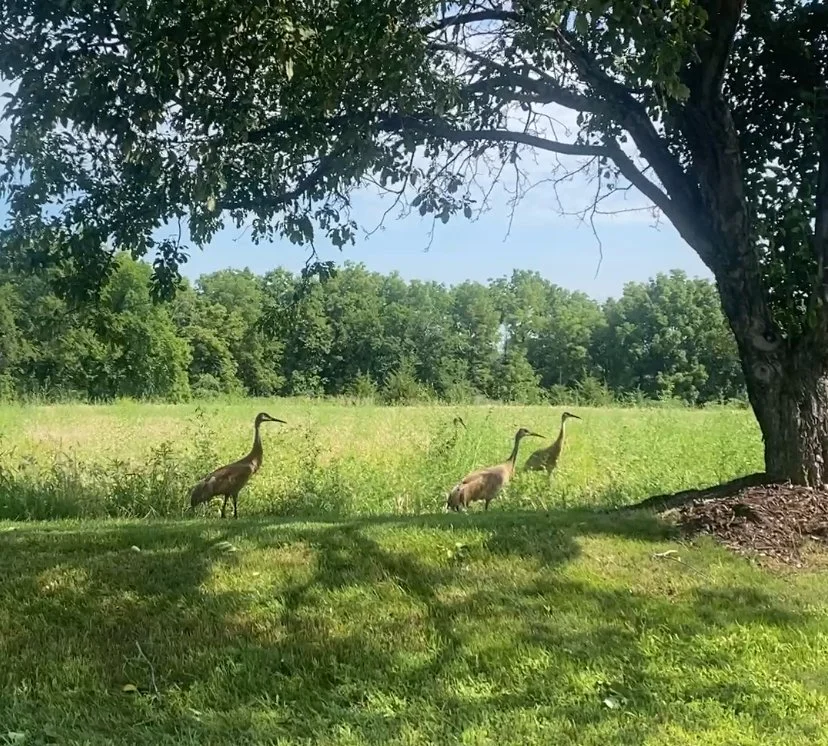Always More to Learn: Sandhill Cranes
Sights and sounds surround me when I am paying attention, and they bring observations and surprises that also bring curiosity. I heard these sandhill cranes before I saw them. I was running nearby our home, where we have seen and heard other glimpses of these interesting creatures in the grassy area behind them in the picture. Sometimes I just want the experience. That day, I wanted a picture too.
My phone identified them as sandhill cranes, which further added to my curiosity. Easy searching on the internet does have its perks. I found out that sandhill cranes, once rare in Minnesota, are now a pretty common sight. Why are these four here? The habitat is a good fit. Did they get separated from a larger group for some reason? Is this a mated pair and their offspring? Two pairs? I don’t need an answer, but the questions bring a sense of connection and belonging. I believe we do need more of both of these.
I did some further research, gathering this information from the Birds and Blooms website:
*Both parents build a nest from cattails, sedges and grasses, but it is unknown which parent chooses the nesting site. Nests can be up to 40 inches across and 6 inches high.
*A female crane usually lays two pale-colored eggs with brown markings. She shares incubation duties with her mate for up to 32 days.
*Sandhill crane offspring can be ready to leave the nest and even start swimming just eight hours after they hatch. Although the chicks are independently mobile, they will stay with their parents up to 10 months after being born and follow them in migration.
*A sandhill crane fossil that was found in the Macasphalt Shell Pit in Florida is estimated to be 2.5 million years old. Fossils found on the central flyway in Nebraska date back even further.
*Sandhill cranes mate for life and attract their partner via a courtship dance with moves like jumping into the air, bobbing their heads and stretching their wings to span up to 7 feet.
*Cranes are elegant dancers and have one of the most well-known bird mating rituals. Dancing peaks during mating season but can occur any time of year. Experts do not completely understand the behavior, but it seems to play a role in bonding. During their courting rituals, sandhill cranes vocalize, dance, jump, move their heads and extend their wings, which can stretch to 7 feet wide. Curiously, young birds also dance—this is believed to be an important part of their motor development
*During migration, these cranes may travel more than 200 miles a day. They’re fast fliers, reaching speeds of up to 35 miles per hour.
*Cranes are large, long-legged gray birds (up to 48 inches tall) with a distinctive red face patch, but don’t be afraid of them. Most of their diet (90 percent) is plant material, including waste grain, roots, berries, and nuts. Insects and snails are on the menu, too.
I find this all fascinating and continued to do some more reading. Nature is an incredible and accessible source of “always more to learn.” There is “always more to learn” about humans too, and about myself. It is a good thing and advisable to not focus all of my time and energy just studying and observing a few things (my own mind, my phone, a circumstance at my job, a recurring fear, etc.)
By widening my awareness, I exercise my brain, and I believe I also grow as a spiritual being. The ancestors of these sandhill cranes and my human ancestors tell an incredible history. And they remind me of my humble place in it all. Nature always delivers a deep sense of being a small part of a larger whole, and that is a spiritual realization if there ever was one.
Lesson from the sandhill cranes: Dance for no reason other than the joy of it. Speaking of dancing, I will be taking a blog break next week for a family wedding, which will definitely include dancing :-) See you back here in a couple of weeks. Onward!
